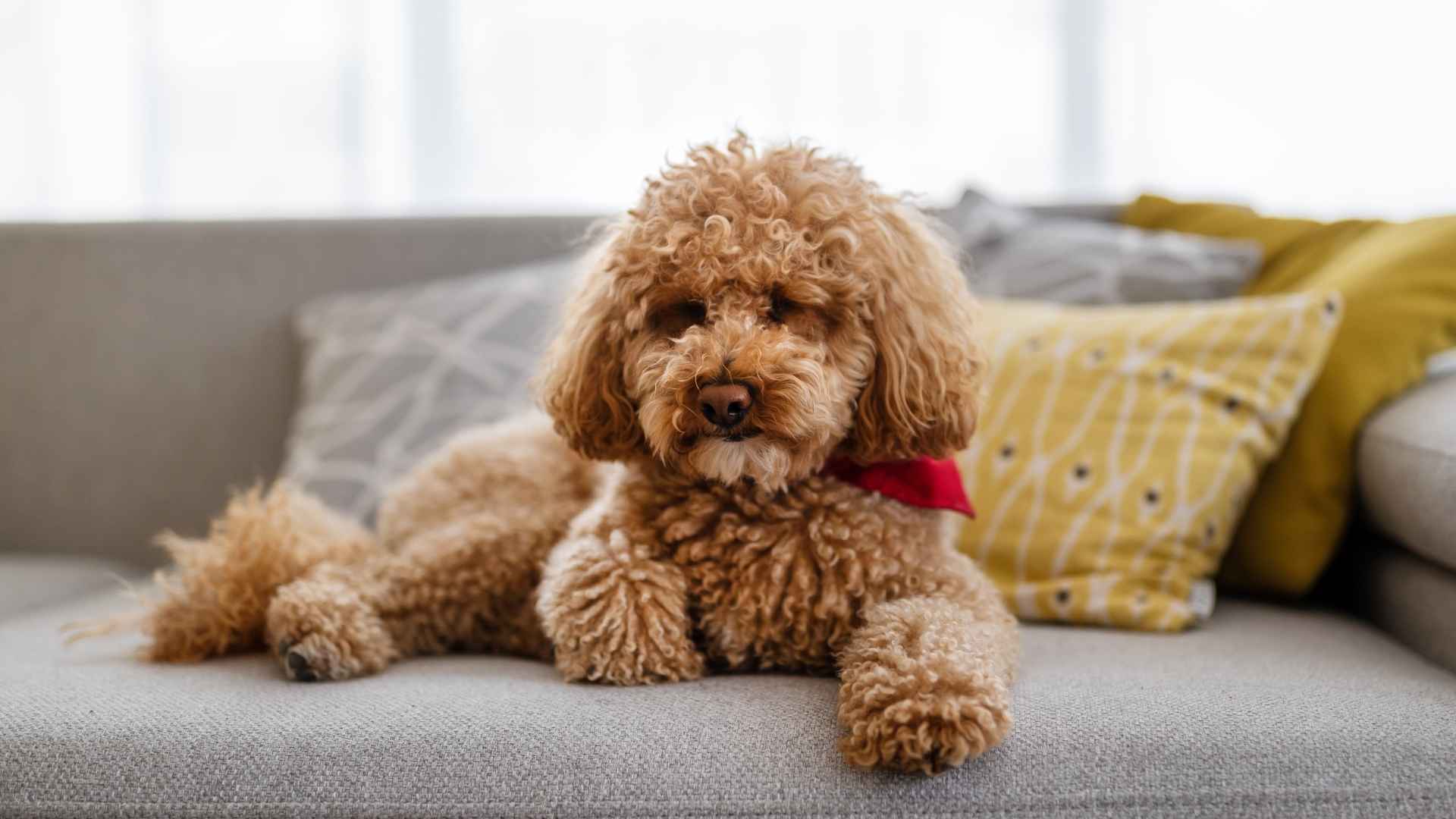If you’ve ever dreamed of bringing home a furry companion but struggle with sneezing, itching, or watery eyes around dogs, you’re not alone. Dog allergies are incredibly common, yet they haven’t stopped pet lovers from finding their perfect match. That’s where hypoallergenic dog breeds come in!
There is no such thing as a 100% hypoallergenic dog, some breeds are known to produce fewer allergens, thanks to their low-shedding coats, minimal dander, and reduced saliva output. These allergy-friendly dogs can be a breath of fresh air—literally—for people with mild to moderate sensitivities.
It’s important to remember, though, that even the most “hypoallergenic” dog can still cause a reaction in some individuals. So, choosing the right breed and spending time with your potential pup before adoption is key. In this blog, we’ll explore some of the best hypoallergenic dog breeds that could be just the cuddly, sniffle-free companion your home has been waiting for.
Hypoallergenic Dog Breeds
1. Norwich Terrier
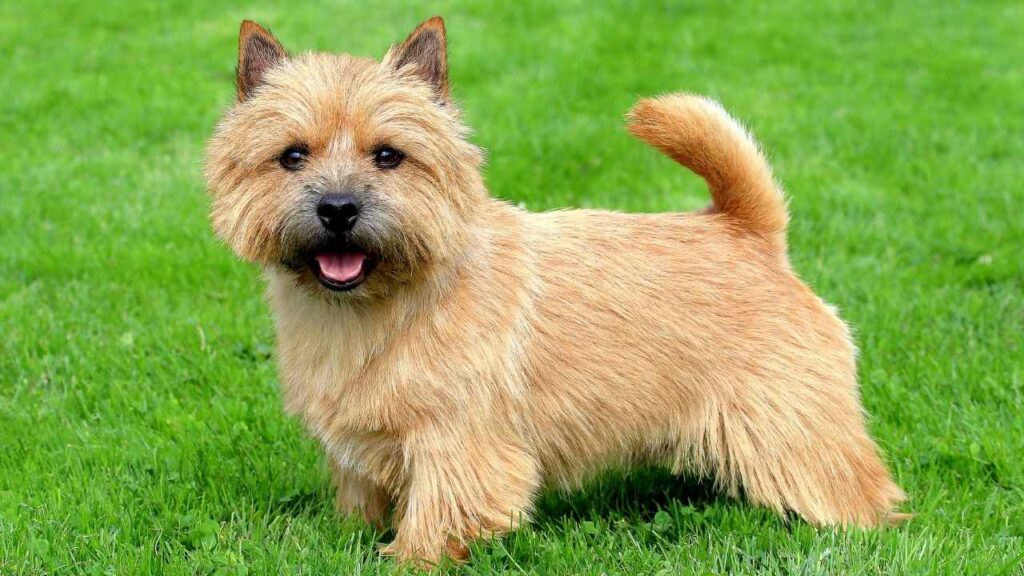
Don’t let the size fool you—the Norwich Terrier might be one of the smallest working terriers, but this pint-sized pup is packed with energy and personality. Known for their cheerful, mischievous nature, Norwich Terriers are eager companions who love joining in on every adventure, according to Purina.
They’re often mistaken for their close cousin, the Norfolk Terrier, but you can tell them apart by their ears: Norwich sport perky, pointed ears, while Norfolks have folded ones. Personality-wise, Norwich Terriers are typically more outgoing and eager to please.
These little dogs thrive on human connection and shower their families with affection and loyalty. Whether you’re living in a busy household or a cozy apartment, the Norwich fits right in. With a fearless spirit and a dash of sass, they’re fun-loving, adaptable, and make excellent family companions.
Thanks to their low-shedding double coat, Norwich Terriers are considered hypoallergenic—a bonus for allergy-prone households. Their weather-resistant outer coat and insulating undercoat do require regular grooming.
To maintain that signature wiry texture and rich color, hand-stripping is preferred over clipping, as it encourages healthy regrowth and preserves coat quality. If you’re up for the grooming routine or can find a skilled groomer, this breed offers charm, companionship, and plenty of tail-wagging fun.
2. Labradoodle
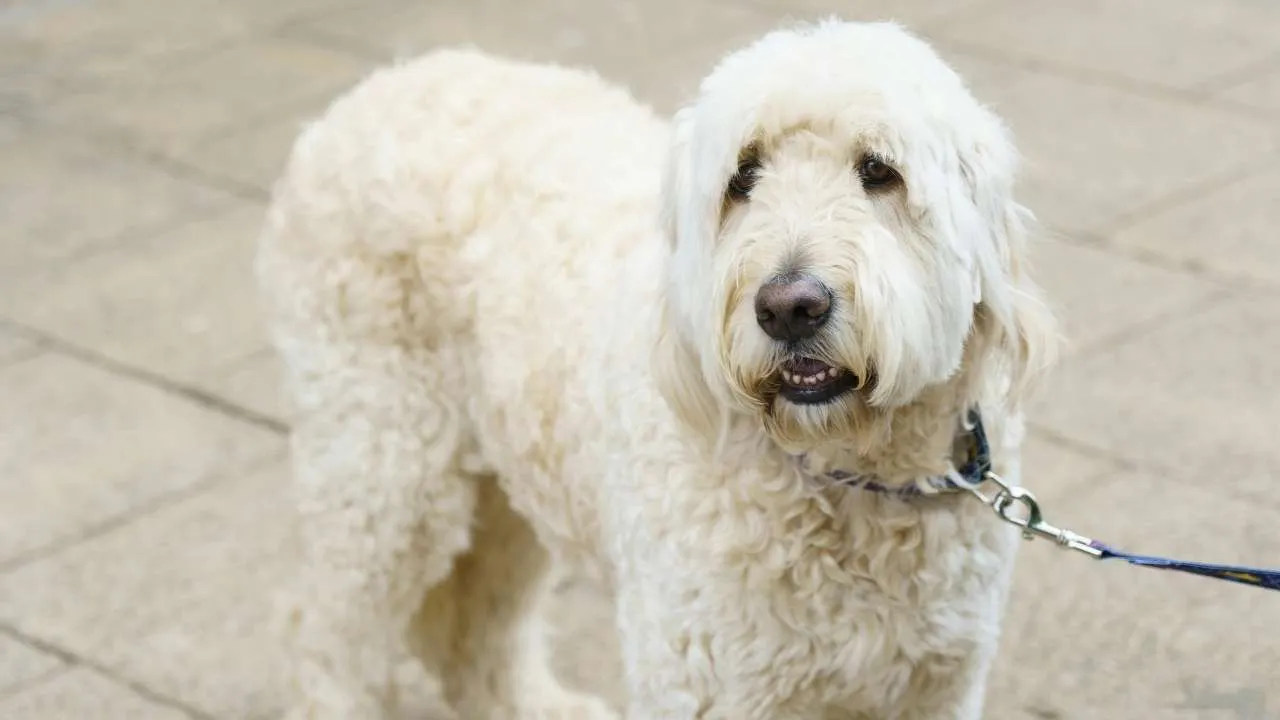
The Labradoodle, a lovable mix between a Labrador Retriever and a Standard Poodle, is a favorite among families—and for good reason. Known for their affectionate personality and playful spirit, these intelligent dogs thrive in active households.
They’re eager to please, friendly with kids and other pets, and full of energy that needs a healthy outlet. Daily exercise, interactive play, and consistent training are essential to keeping a Labradoodle happy and well-behaved.
Labradoodles are social butterflies and love being with their humans. They don’t do well when left alone for long hours and may develop separation anxiety if not properly trained. With the right care, patience, and attention, the Labradoodle makes an incredible, devoted companion—and a joyful addition to any home.
While often labeled hypoallergenic, Labradoodles aren’t completely allergen-free, but they do tend to shed less than many breeds. This is thanks to their Poodle lineage, which contributes a curly, low-dander coat that may be easier on allergy sufferers.
However, it’s worth noting that some Labradoodles shed more than others, depending on their coat type. Sometimes, the most severe allergic reactions are often triggered by proteins found in a dog’s saliva, dander, and urine, not just their fur.
Their coat, while soft and adorable, needs serious upkeep. Without regular grooming, those curls can tangle and mat, making your pup uncomfortable. Brushing several times a week and scheduling trims will help keep their coat clean, healthy, and manageable.
3. Poodle

Often mistaken as pampered lapdogs, Poodles are actually hardworking retrievers with a rich history in hunting. Originally bred in Germany, not France, as many believe—their name comes from the German word “pudel,” meaning “to splash in water.”
As noted by PetPlan, Poodles come in three sizes—Standard or Miniature poodle and Toy Poodle. These are among the most intelligent dog breeds in the world. Their sharp minds and friendly temperaments make them wonderful companions. They’re also popular choices for crossbreeding, giving rise to favorites like the Cockapoo and Labradoodle.
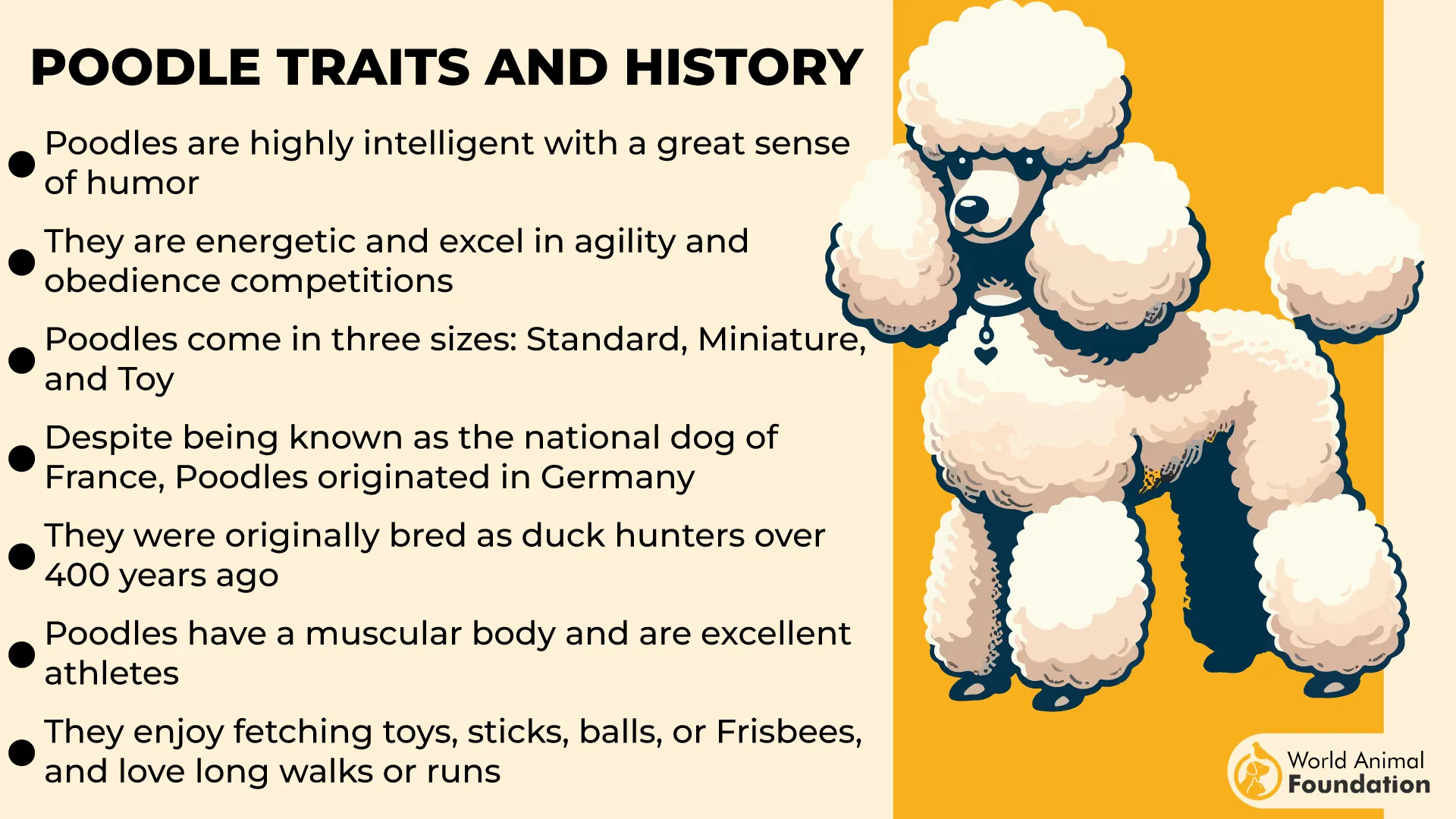
What truly sets Poodles apart is their signature curly coat, which resembles lamb’s wool. It comes in a wide range of solid colors, including white, black, brown, silver, apricot, and red. Because their dense, single-layer pet hair grows continuously and doesn’t shed like typical fur, Poodles are often labeled hypoallergenic.
That said, their coat isn’t low-maintenance. Daily brushing is essential to avoid mats and tangles, and professional grooming every 6 weeks helps keep their curls healthy and manageable. Poodle hair, much like human hair, is affected by hormonal changes, and female Poodles may experience temporary thinning after having puppies, states AKC.
If you’re into dog fashion, you’ll be happy to know there are several recognized Poodle hairstyles—especially in the show ring. From the elaborate Continental Clip to the classic English Saddle, each haircut follows very specific grooming rules.
Even Poodle puppies have their own signature style called the Puppy Clip, which keeps the coat evenly trimmed all over.
4. Havanese
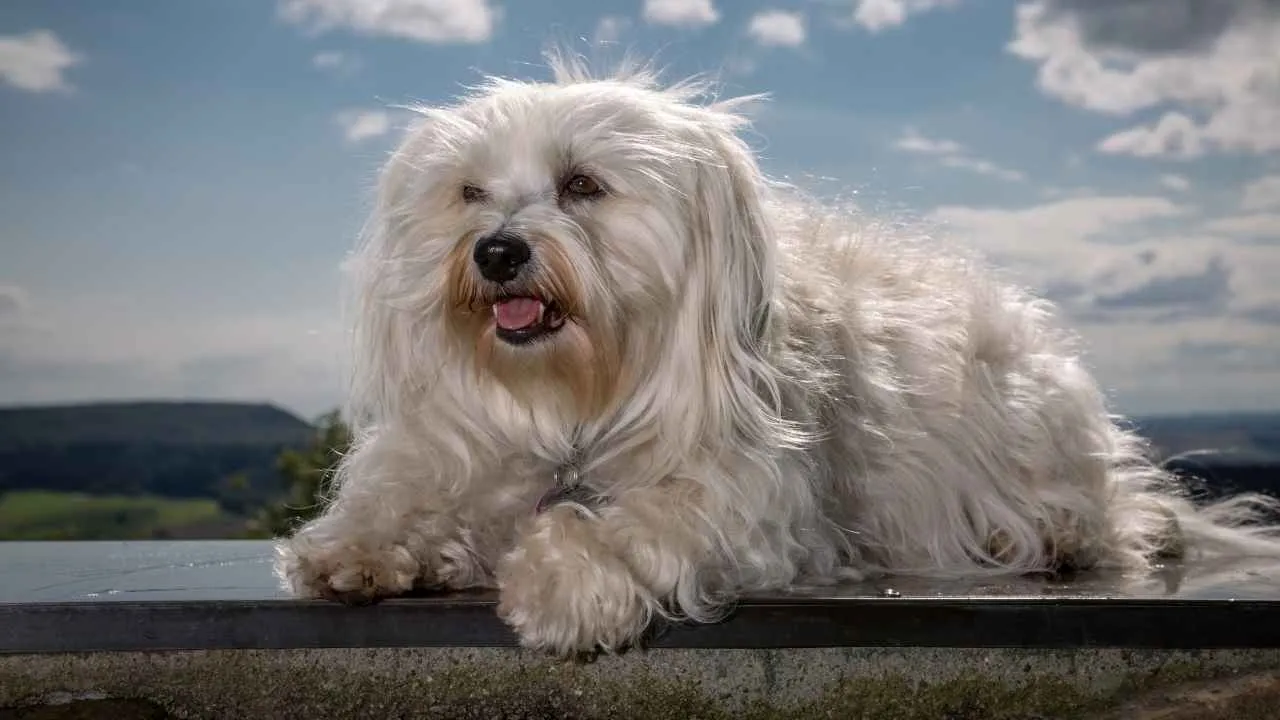
The Havanese, Cuba’s charming native breed, is a small toy dog with a big heart. With their rounded face, floppy ears, and long, silky coat that can be straight, wavy, or curly, they’re undeniably adorable—but it’s their personality that wins hearts. Friendly, affectionate, and highly social, Havanese dogs get along wonderfully with children, other dogs, strangers, and even cats.
Bred to be companion animals, Havanese are true Velcro dogs—wherever you go, they’ll want to follow. This deep devotion makes them a joy to live with, but also means they don’t cope well with being left alone.
Beyond their cuddly nature, Havanese are smart and eager to please, making training a breeze. They’ve proven their versatility as therapy dogs, detection dogs, and even little athletes, excelling in agility, flyball, and obedience competitions. Their playful and clownish spirit brings joy to any household, and they love to be involved in family life.
When it comes to grooming, their lush double coat is definitely high maintenance. Whether it’s sleek or curly, the Havanese coat needs brushing at least twice a week to prevent painful mats and tangles.
However, these small hypoallergenic dogs rarely shed, making them a suitable option for allergy-prone families, though, as with all dogs, they’re not completely allergen-free.
With their loving nature, low-shedding coat, and zest for life, the Havanese makes a delightful addition to the right home. Just be sure they’re not left alone for too long—these cheerful companions are happiest when they’re close to the ones they love.
5. Shih Tzu
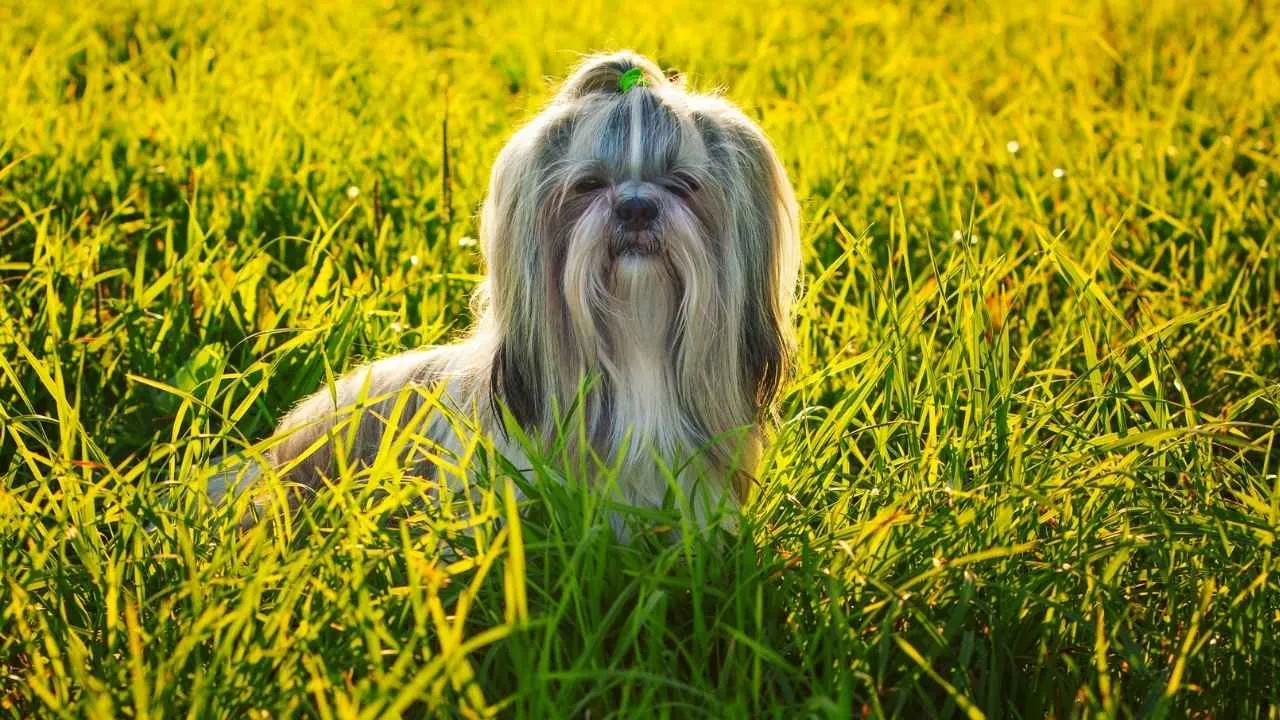
The Shih Tzu, often referred to as the “lion dog,” has a rich history rooted in Tibetan and Chinese royalty. Originally developed from breeds like the Lhasa Apso and Pekingese, these tiny companions were cherished by Buddhist monks and gifted to Chinese emperors. Their name, shih-tzu kou, translates to “lion dog,” a nod to the breed’s symbolic connection to the Buddhist lion.
Known for their regal appearance, Shih Tzus boast a flowing double coat that sweeps the floor like a tiny royal cloak. Their expressive, round eyes and flat, “chrysanthemum face” give them a human-like charm that endears them to just about everyone.
True to their heritage, Shih Tzus were bred for companionship and excel at it. These lovable lap dogs thrive on human interaction, often trailing behind their owners throughout the house and happily curling up in any available lap. Their calm and confident nature makes them well-suited for apartment living, families with children, and multi-pet households.
When it comes to grooming needs, Shih Tzus do require a bit of commitment. Their luxurious coats need to be brushed every day or two to prevent tangles and matting. Many pet parents opt for shorter, manageable trims, while show dogs often sport the signature long look, complete with topknots and hair wraps.
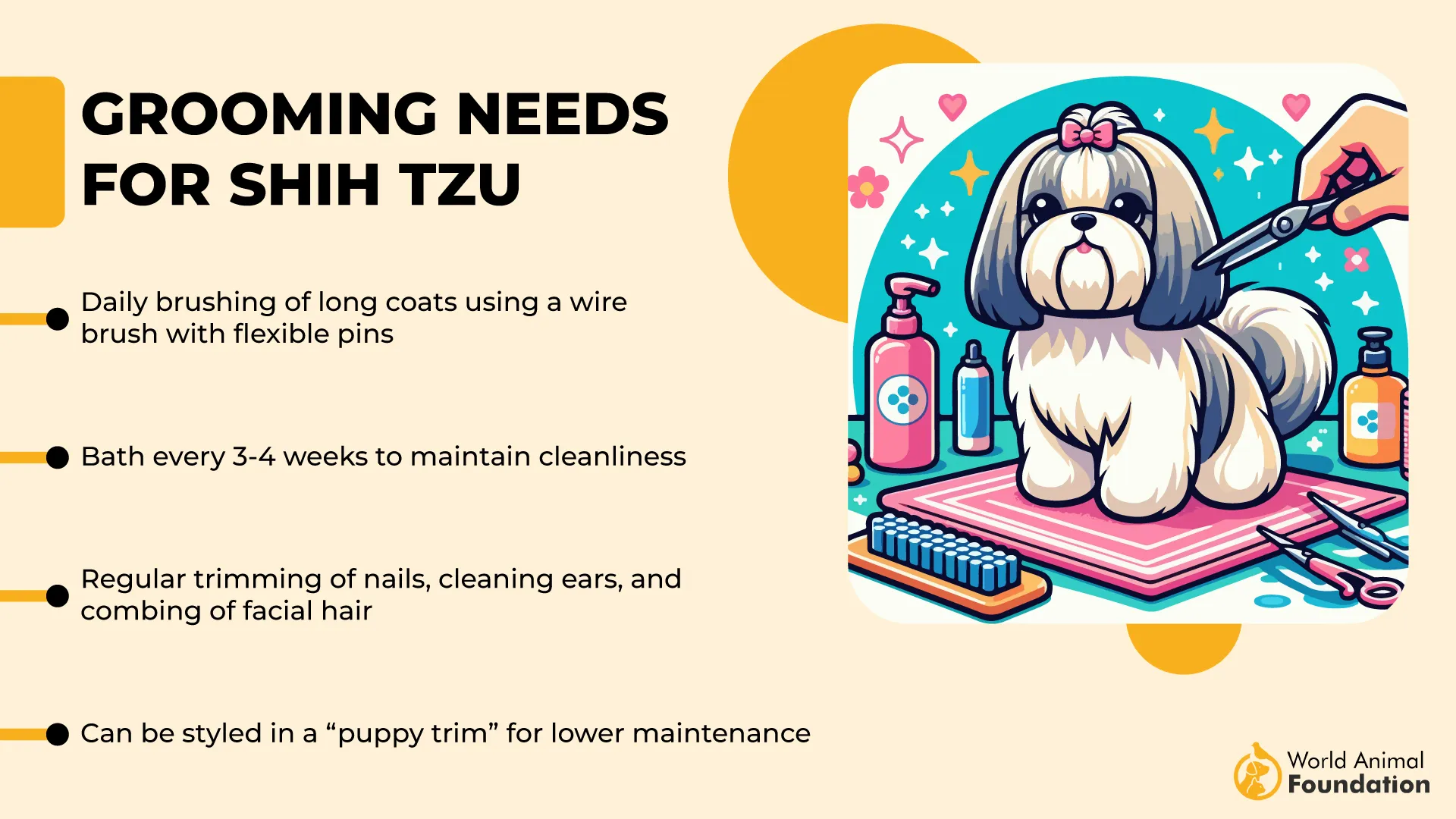
Despite their glamorous locks, Shih Tzus are considered a hypoallergenic breed. Their dense coat tends to trap loose hair and pet dander, reducing the spread of allergens in your home. Paired with consistent grooming, this makes them a suitable option for those with mild pet allergies.
6. Bichon Frise
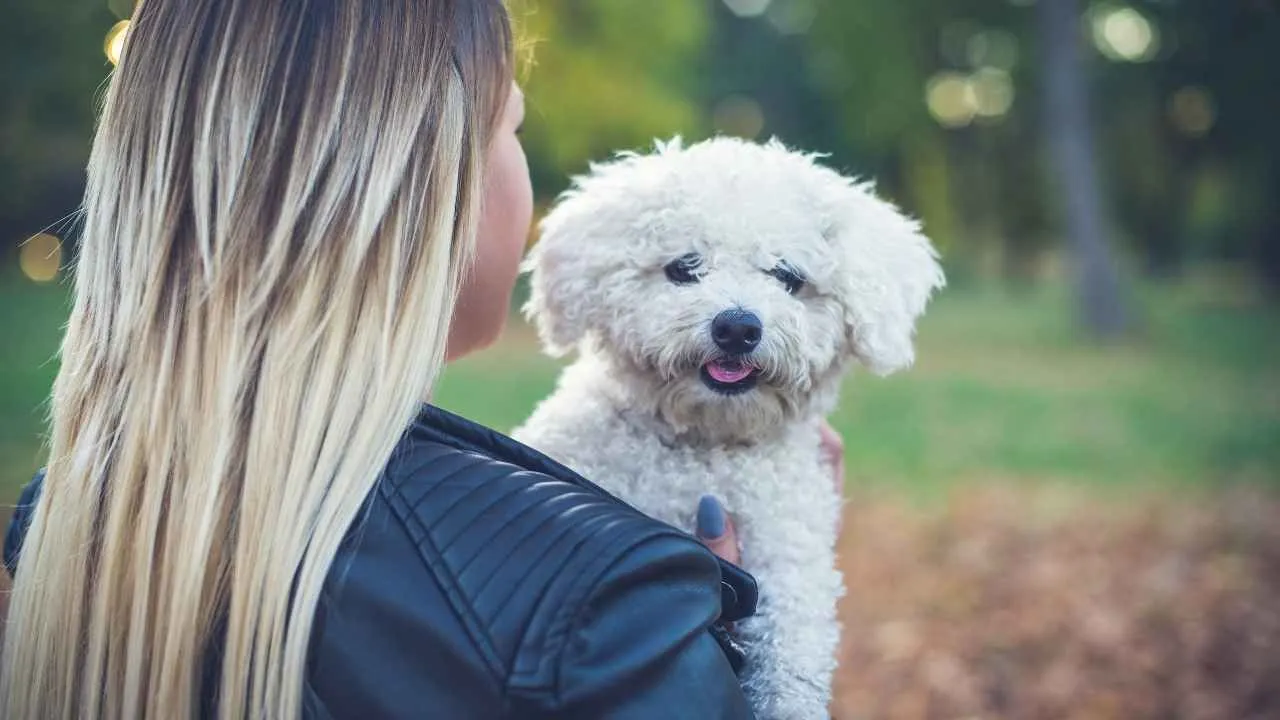
The Bichon Frise is an adorable, small dog breed with a big personality wrapped in a fluffy white coat. With their curious nature and friendly demeanor, Bichons get along famously with kids, cats, and fellow canines. These sociable pups love being at the center of attention and make wonderful family members.
Bichon is full of energy and affection. They thrive in homes where they’re rarely left alone, as they form strong bonds with their humans and may develop separation anxiety if isolated for too long. Early socialization and consistent training are essential, especially since these little charmers can be quite vocal.
One of the breed’s standout features is its soft, curly coat, which is often labeled hypoallergenic. While no dog is completely allergy-free, Bichons tend to shed very little and produce less dander. This makes them a better fit for some allergy sufferers, especially when paired with regular grooming to keep allergens in check.
Regular coat maintenance is a must for the Bichon. Their dense curls can trap dander, dust, and even pollen from the environment, so frequent brushing and bathing help keep both the dog and your home allergen-friendly. It’s also worth noting that proteins in a dog’s saliva and grooming products can trigger allergic reactions, so choosing the right products is just as important.
Smart and eager to please, Bichons are quick learners and respond well to positive reinforcement. Their combination of brains, beauty, and charm makes them a firm favorite for families, especially those who want a loving companion who is always ready to brighten the day.
7. Portuguese Water Dog
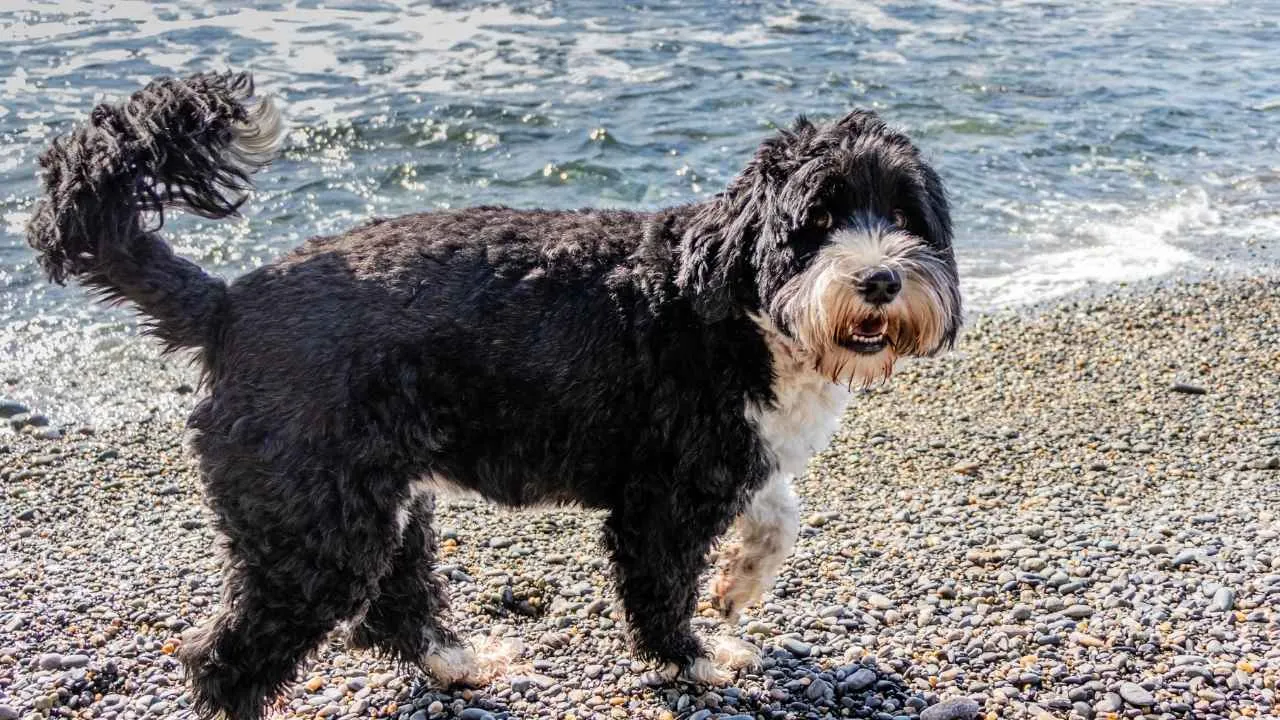
The Portuguese Water Dog, often affectionately called the “Portie,” is a spirited, intelligent, and athletic breed originally developed to work alongside fishermen along Portugal’s coast. These hardworking pups were trained to retrieve fishing nets, carry messages between boats, and even herd fish into traps.
Porties are known for their teddy bear-like appearance, cheerful demeanor, and devotion to their families. They’re happiest when close to their people and make loving companions for active households.
Hillspet states that Portuguese Water Dogs are loved for their affectionate nature. This energetic breed requires plenty of mental and physical stimulation to stay balanced. Without regular activity, they can grow bored and develop undesirable habits.
These dogs have a distinctive coat that can be curly or wavy, coming in colors like black, brown, white, or combinations of these. One of the biggest perks? They don’t shed like most other breeds, making them a popular choice for allergy-sensitive pet parents. That said, grooming is essential, both for coat maintenance and hygiene.
Owners often choose between two traditional trims: the “lion clip”, where the rear and face are shaved and the rest is left full, or the “retriever clip”, which keeps the entire coat trimmed to a short, manageable length while leaving the tail plume intact.
Their smarts and energy make Portuguese Water Dogs stars in canine sports. From agility and dock diving to obedience and rally competitions, they thrive when given a job to do.
8. Bedlington Terrier
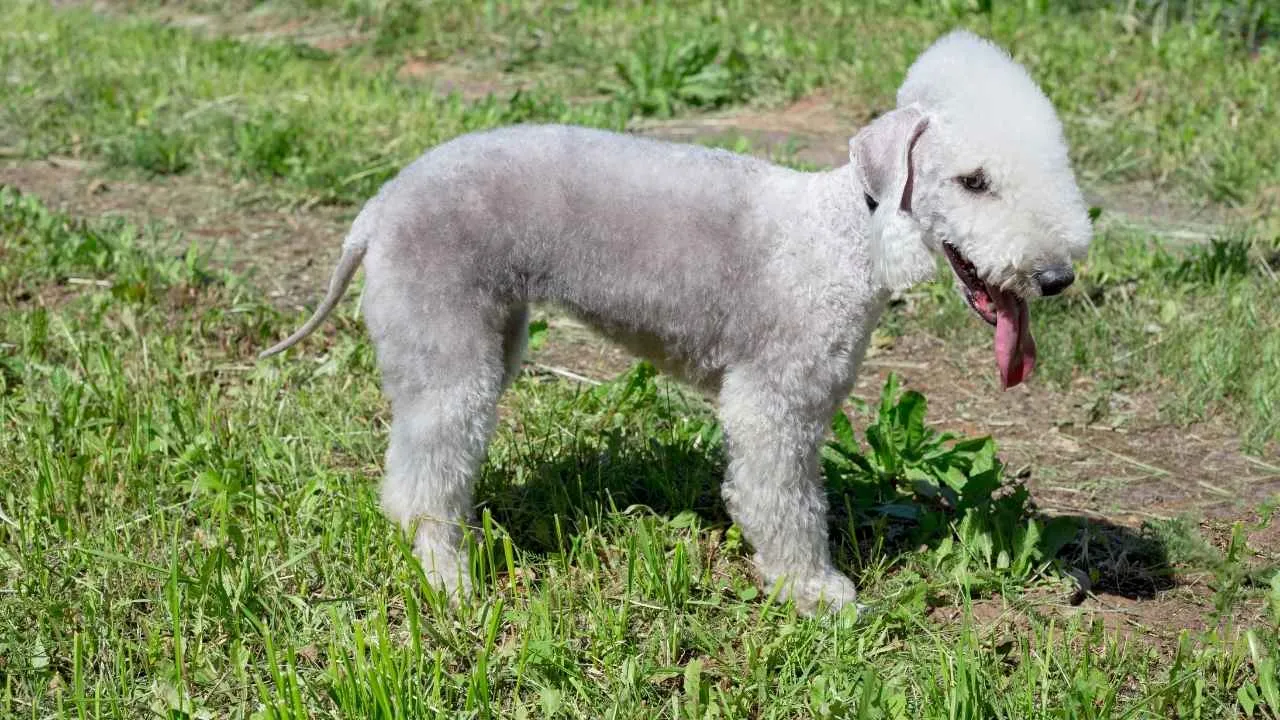
The Bedlington Terrier is one of the most unique-looking dog breeds around—often described as a lamb with attitude. This small English terrier stands out with its arched back, curly coat, and pear-shaped head topped with a soft, fluffy tuft. The look may be gentle, but beneath that fleece-like exterior is a lively, athletic dog full of character.
Though rare today—partly due to inherited liver issues that affected the breed in the ’70s and ’80s—the Bedlington remains a gem for dog lovers seeking a distinctive companion. Their coat texture is a fascinating mix of soft and coarse (but not wiry) hair, which doesn’t shed much, making the breed a potential fit for allergy-sensitive homes.
Personality-wise, Bedlingtons are classic terriers: clever, confident, and a bit stubborn. Early training and consistent socialization go a long way in shaping a well-mannered dog. Bred to chase, they have a strong prey drive, so supervision around smaller animals is recommended.
Grooming is key to keeping that iconic appearance intact. Their fast-growing coat needs trimming roughly every six weeks, either at home with clippers and scissors or with a professional groomer.
Their signature look also calls for hand-scissoring around the face and routine brushing a couple of times a week to prevent matting.
Surprisingly adaptable, Bedlingtons do well even in apartments as long as they get ample exercise. These low-shedding dogs are a great pick for allergy sufferers and anyone who wants a dog that’s truly one of a kind.
9. Airedale Terrier
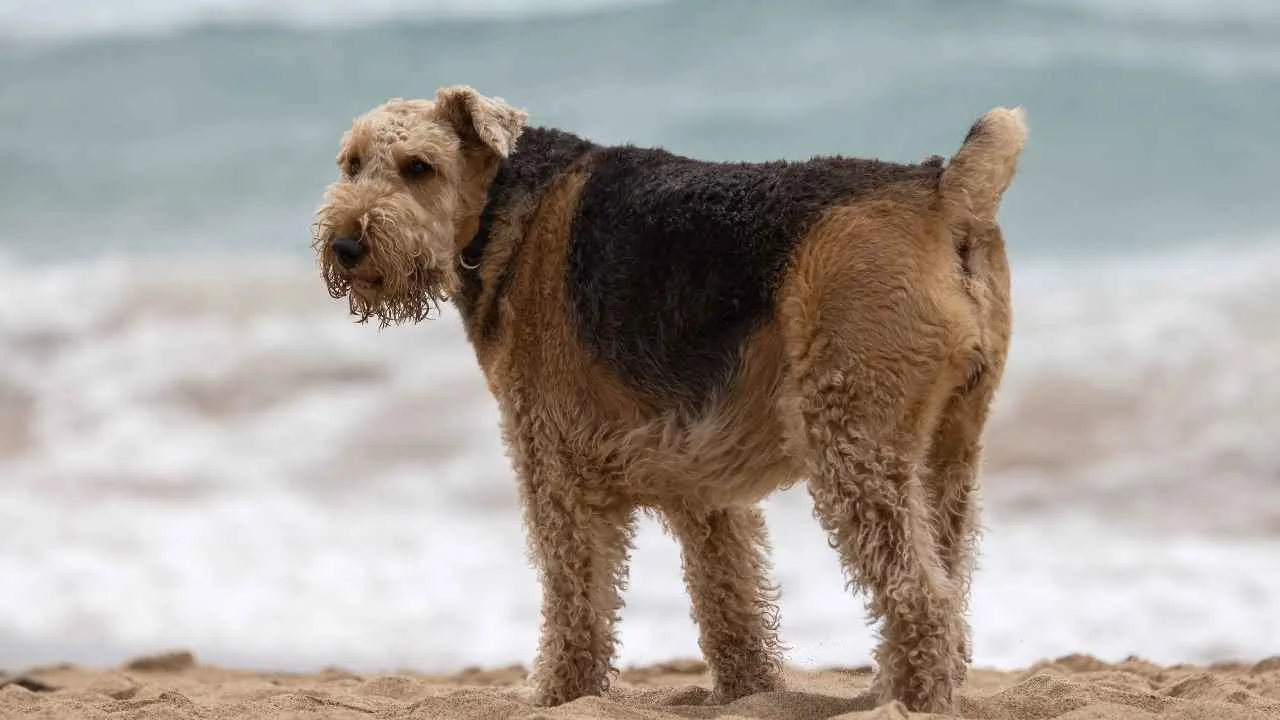
The Airedale Terrier, often called “the king of terriers,” is a medium-sized breed that originated in England. Recognizable by its classic terrier head, V-shaped floppy ears, erect tail, and sturdy, square frame, this dog exudes confidence and character. Known for being sharp-witted and energetic, the Airedale isn’t usually the best fit for first-time dog owners due to its strong-willed nature.
Renowned as one of the smartest terrier breeds, Airedales combine intelligence with an independent streak that gives them a lot of personality. While deeply loyal and affectionate, their love is on their own terms, so if you’re hoping for a cuddly lapdog, this breed might not meet those expectations.
When it comes to grooming, Airedales are relatively low-maintenance. Their dense, wiry coat requires just a weekly brushing to remove dead hair and keep it healthy.
Airedales are considered hypoallergenic due to their low-shedding coats, which help limit the spread of allergens like dander and dead skin. While not allergy-free, they may be a suitable choice for people with mild sensitivities.
Another perk for allergy sufferers is that Airedales aren’t particularly drooly, which can make a significant difference for sensitive noses. Of course, individual reactions vary, but if you have minor allergic symptoms, this breed might be a more comfortable companion than others.
Conclusion
While no dog is truly allergy-free, many hypoallergenic dogs tend to produce fewer allergens, making them a better fit for sensitive owners. Breeds like the Soft Coated Wheaten Terrier, Irish Water Spaniel, Afghan Hound, and the three Schnauzer breeds—including the Giant and Miniature Schnauzer—offer a range of sizes from small to large hypoallergenic dogs.
Even hairless dogs, such as the American Hairless Terrier, and low-shedding mixed breeds can help manage allergies when paired with frequent grooming and a nutritious diet. Ultimately, understanding factors like dead skin cells, thick or silky hair, and the traits of parent breeds can help allergy-prone individuals find the right fit.
With the right care, even most dogs with a friendly nature can thrive in active families while minimizing allergy symptoms.


